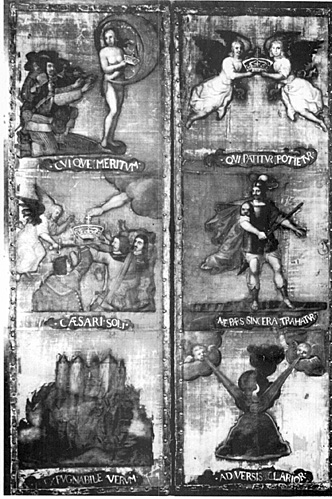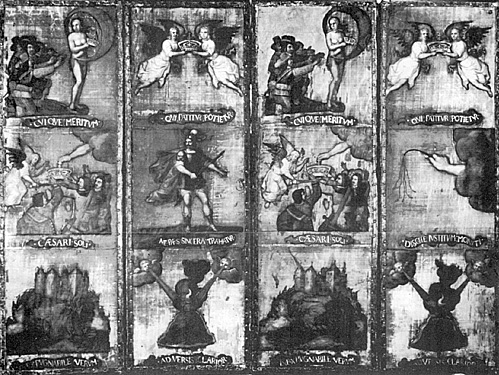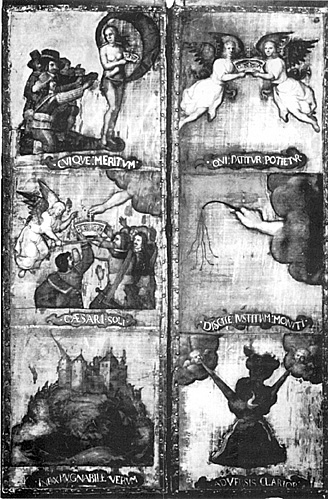The Museum of London recently acquired a flame-coloured silk folding screen, consisting of four panels, each measuring 64 x 20 inches, and each showing three devices, or pictures, painted in oil on a silk background, and with a Latin motto beneath. Of the twelve devices five are repeat designs. The style of painting and costume detail is datable to the 1640's or 1650's, and presumably is the work of a member of the Painter- Stainers Company.
Natalie Rothstein of the Victoria & Albert Museum has commented that the 17th century silk was probably imported from Florence, and the devices painted in the weft, not the warp direction of the fabric, ie. the 'wrong' or 'weaker' direction. This implies the silk was a re-used, faded or damaged fabric, probably from finishings, such as the valence from a set of bed curtains. Any surviving lining or interlining would have been useful as a stiffener for the flags.
The emblematic devices have been identified as a unique set of civil war royalist cavalry cornets (flags) originally each measuring 24" square, but now lacking their fringes and polesleeves. Fragments of the sleeves do exist in some instances how.ever, and so help prove their function as flags. They were trimmed down for mounting on the screen panels at a later date (hence the positioning of the mottoes very close to the edge of each flag) certainly by about 1800, judging from the style of the screen's surrounding leather trim. The panels were subsequently backed with a cotton power-loom woven jacquard fabric, probably Halifax, c.1840-45.
Emblematic devices were a common feature on furnishings, in interior decoration and for civic pageantry and the like and their meaning readily identified by contemporaries, although obscure today. Religious symbols, such as angels and saints, and mythological characters like Mars or Fortune, were used as devices on flags flown in the Thirty Years War and were familiar to English soldiers serving abroad. The use of Latin mottoes, especially, would have been considered the sign of an educated man.
The emblems on the panels are (from left, upper corner):
i - Fortune holding the crown away from the out-stretched hands of five armed men dressed in the style of the 1640's, and with the motto CUIQUE MERITUM (To each his deserts).
ii - An angel cutting off five hands from men as they seek possession of the crown, and the motto CAESARI SOLI (For Caesar Alone) .
iii - Two angels holding a crown and QUI PATITUR POTIETUR (The one who suffers will be master).
iv - A warrior dressed in classical garb, like Mars, cutting his arm with his own sword, NE PARS SINCERA TRAHATUR (Lest the part be squandered unhurt).
v - Opposing winds blown by two cherubim fan the flame of a bonfire, ADVERSIS CLARIOR (Brighter with events against you).
vi - A castle on a rock, pounded by waves, INEXPUGNABILE VERUM (The impregnable truth).
vii - A hand issuing from a cloud and holding a scurge, DISCITE IUSTITIAM MONITI (Learn justice having been warned).
Each flag would have belonged to a particular troop of horse, and the captain who had raised them. The panels show five troops of horse (the flags are double sided and the pictures repeated, as mentioned above) and possibly a sixth with differing obverse and reverse - the warrior and the hand with the scurge. The similarity in design and field colour indicate they all belong to the same regiment. Although some five hundred civil war flags are known from documentary sources, this set is unrecorded. Only two other contemporary cavalry flags survive a Royalist and a Parliamentary example, both at St. Mary's Church, Bromsberrow, Gloucestershire.
The work of identifying the devices, and the regiment and captains of the troops of horse continues. Only then can we interpret the military role of the regiment in the Civil War. Preliminary invesngations reveal that the device on the upper Ift hand corner panel (CVIQUE MERITUM) was that of Colonel Robert Hatton, ave in the Kentish Rising of 1648. I am most grateful to Sir Oliver Millar, Natalie Rothstein, Dr. Malcolm Rogers (NPG), Janet Arnold, Frances Pritchard, William Carman and many military colleagues for their comments and advice.
The Museum of London wishes to acknowledge the generous financial assistance of the National Art Co!lections Fund and the National Heritage Memorial Fund towards the purchase of the flags together with the help of the Pilgrim Trust and the Idlewild Trust with conservation costs, carried out by the Textile Conservation Centre, Hampton Court.
Cornets



Back to English Civil War Times No. 47 Table of Contents
Back to English Civil War Times List of Issues
Back to Master Magazine List
© Copyright 1993 by Partizan Press
This article appears in MagWeb (Magazine Web) on the Internet World Wide Web.
Other military history articles and gaming articles are available at http://www.magweb.com